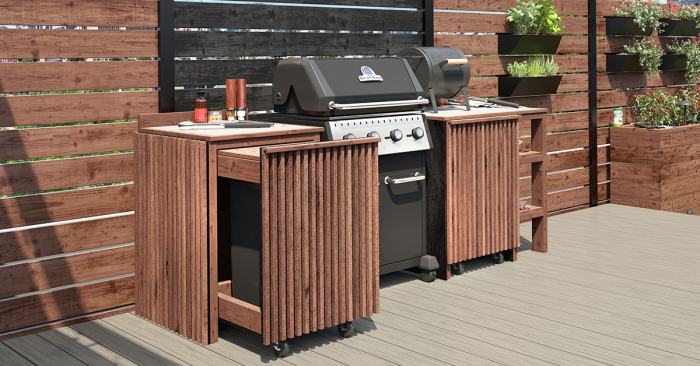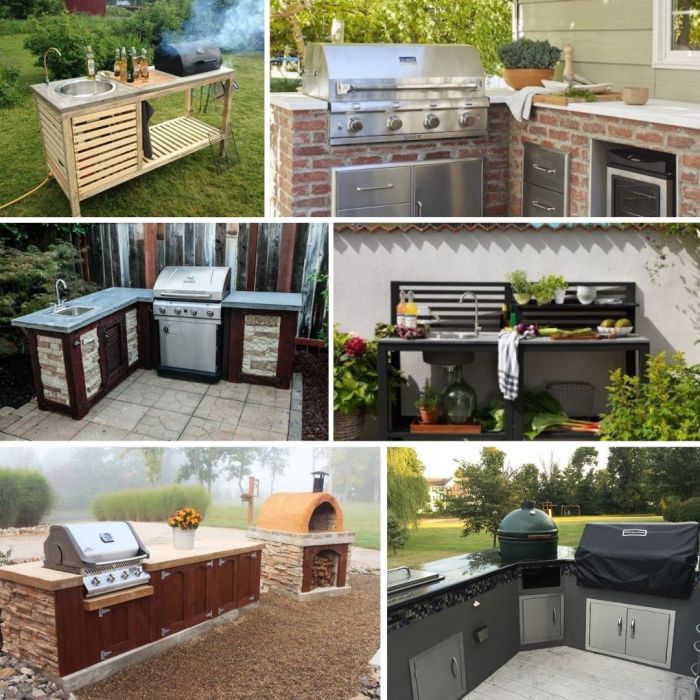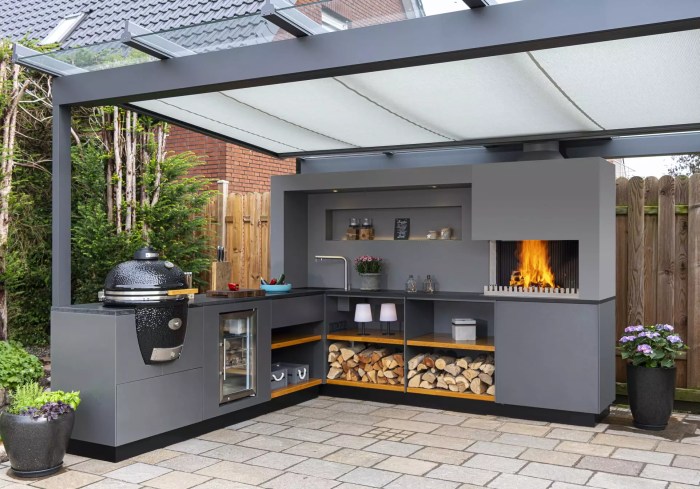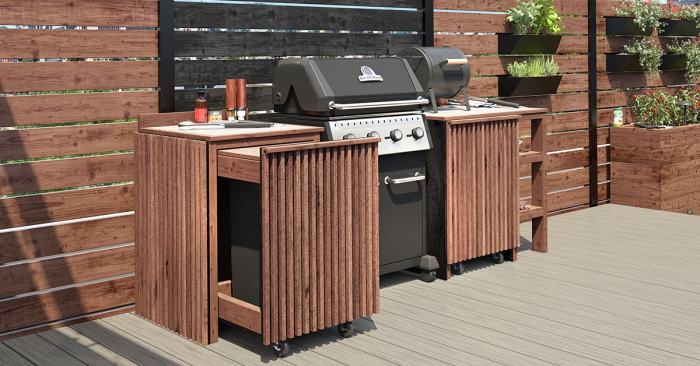DIY outdoor kitchen designs offer a unique opportunity to create a personalized haven for culinary adventures and unforgettable gatherings. Imagine a space where you can grill, smoke, and cook up a storm while surrounded by the beauty of your backyard. Whether you envision a simple setup or a full-fledged culinary masterpiece, the possibilities are endless with a DIY outdoor kitchen.
From planning the layout to selecting materials and installing appliances, this guide will walk you through every step of the process, providing practical tips and inspiring ideas along the way. With careful planning and a bit of creativity, you can transform your outdoor space into a functional and aesthetically pleasing haven for outdoor living.
Building the Structure

The foundation of your outdoor kitchen is the structure. It’s what will hold everything together and provide the base for your countertops, appliances, and storage. You’ll need to choose the right materials and build a sturdy frame to ensure your outdoor kitchen lasts for years to come.
Materials for the Structure
The material you choose for your outdoor kitchen structure will depend on your budget, desired aesthetic, and the climate you live in. Here are some of the most popular options:
- Brick: Durable, fire-resistant, and aesthetically pleasing, brick is a great choice for outdoor kitchens. It can withstand extreme temperatures and weather conditions. However, brick can be expensive and requires skilled labor to install.
- Stone: Similar to brick, stone is a durable and attractive option. It comes in a wide variety of styles and colors, allowing you to create a unique look. Stone can be more expensive than brick and may require specialized tools for installation.
- Concrete: Concrete is a cost-effective and versatile material that can be molded into various shapes. It is also very durable and resistant to moisture and pests. However, concrete can be difficult to work with and may require specialized equipment for installation.
- Wood: Wood is a warm and inviting material that can add a rustic charm to your outdoor kitchen. It is relatively easy to work with and can be customized to fit your needs. However, wood is susceptible to moisture damage and requires regular maintenance to prevent rot and decay.
Building a Basic Outdoor Kitchen Frame
A basic outdoor kitchen frame can be built using wood, metal, or a combination of both. The frame should be strong enough to support the weight of your countertops, appliances, and other components. Here are some steps to building a basic frame:
- Determine the size and layout of your outdoor kitchen. Consider the space you have available and the appliances and features you want to include. A simple layout can include a countertop, a sink, and a grill. More elaborate designs may include a refrigerator, an oven, and even a pizza oven.
- Create a plan and gather the necessary materials. This includes wood or metal framing, fasteners, and any other necessary materials. Consider using pressure-treated lumber for outdoor applications to resist moisture and decay.
- Build the frame using your chosen materials. Use levelers to ensure that the frame is square and level. Securely fasten the frame together using appropriate fasteners.
- Add additional support if needed. If your outdoor kitchen is large or will be supporting heavy appliances, you may need to add additional support beams or columns.
Countertop Materials
Countertop materials play a crucial role in your outdoor kitchen’s functionality and aesthetics. Here are some popular options and their pros and cons:
- Granite: A durable and heat-resistant natural stone option, granite is highly resistant to scratches and stains. It comes in a wide variety of colors and patterns. However, granite can be expensive and requires professional installation.
- Quartz: A man-made stone option, quartz is very durable and resistant to scratches, stains, and heat. It comes in a wide variety of colors and patterns. Quartz is also relatively easy to maintain.
- Stainless Steel: A durable and easy-to-clean material, stainless steel is often used in commercial kitchens. It is heat-resistant and can withstand harsh weather conditions. However, stainless steel can be prone to scratches and may require special cleaning products to prevent rust.
- Tile: Tile is a versatile and affordable countertop option. It comes in a wide variety of styles and colors, allowing you to create a unique look. Tile is also relatively easy to install. However, tile can be prone to cracking and may require sealing to prevent water damage.
Creating a Durable and Weather-Resistant Finish
A durable and weather-resistant finish is essential for your outdoor kitchen to withstand the elements. Here are some tips:
- Use high-quality materials. Choose materials that are specifically designed for outdoor use and can withstand moisture, temperature fluctuations, and UV rays. Consider using pressure-treated lumber, stainless steel, or weather-resistant paints and coatings.
- Apply a sealant. Apply a sealant to your countertops, walls, and other surfaces to protect them from moisture, stains, and UV damage. There are various sealants available, so choose one that is specifically designed for the materials you are using.
- Use weather-resistant paint or coatings. Paint or coat your outdoor kitchen with a weather-resistant finish to protect it from the elements. Choose a paint or coating that is specifically designed for outdoor use and can withstand moisture, temperature fluctuations, and UV rays.
- Maintain your outdoor kitchen regularly. Regular maintenance is essential for keeping your outdoor kitchen looking its best and extending its lifespan. Clean and seal your surfaces regularly, and inspect for any signs of damage or wear. Make any necessary repairs promptly to prevent further damage.
Designing the Aesthetics: Diy Outdoor Kitchen Designs

Your outdoor kitchen is an extension of your home, and its aesthetics should complement the overall style of your property. You want to create a space that’s both functional and visually appealing. Here’s how you can achieve this.
Color Palettes and Materials
The choice of color palettes and materials is crucial for achieving a cohesive look. You can use a color scheme that harmonizes with the surrounding environment. For instance, if your home has a rustic charm, incorporating natural elements like wood and stone can enhance the ambiance. Alternatively, if your home is modern, opting for sleek stainless steel and minimalist designs can create a contemporary feel.
Lighting Options
Proper lighting is essential for setting the mood and ensuring functionality in your outdoor kitchen.
- Consider using a combination of ambient lighting, task lighting, and accent lighting.
- Ambient lighting, such as string lights or lanterns, can create a warm and inviting atmosphere.
- Task lighting, like spotlights over the cooking area, provides sufficient illumination for preparing meals.
- Accent lighting, such as spotlights highlighting decorative elements, can add depth and dimension to the space.
Decorative Elements
Incorporating decorative elements can transform your outdoor kitchen into a haven.
- Plants: Adding greenery can bring life and vibrancy to your space. Consider using potted herbs, flowering plants, or climbing vines to create a natural and inviting atmosphere.
- Fountains: The soothing sound of water can enhance the ambiance of your outdoor kitchen. Fountains come in various sizes and styles, so you can choose one that complements your design.
- Sculptures: Sculptures can add a touch of artistry and personality to your outdoor kitchen. Choose sculptures that reflect your personal style and complement the overall aesthetic of your space.
Essential Tools and Equipment

Building an outdoor kitchen requires a variety of tools and equipment, from basic hand tools to specialized power tools. Having the right tools will make the project easier, faster, and more enjoyable.
Choosing the Right Tools
Choosing the right tools for your outdoor kitchen project depends on the specific tasks you plan to undertake. Consider the materials you will be working with, the complexity of the project, and your own level of experience. For example, if you are building a simple countertop with pre-fabricated cabinets, you will need different tools than if you are constructing a custom-built kitchen with stone countertops and a built-in grill.
Essential Hand Tools
- Measuring Tape: A must-have for accurately measuring and cutting materials.
- Level: Essential for ensuring that surfaces are level and plumb.
- Hammer: Used for driving nails, securing fasteners, and breaking up materials.
- Screwdriver: A variety of screwdrivers are essential for working with screws, including Phillips, flathead, and Torx.
- Pliers: Used for gripping, bending, and cutting wire, and for holding small parts.
- Wrench Set: A set of wrenches is essential for tightening and loosening nuts and bolts.
- Utility Knife: Used for cutting various materials, including cardboard, tape, and plastic.
- Chisel: Used for carving, shaping, and removing material.
- Safety Glasses: Protect your eyes from debris and flying objects.
- Work Gloves: Protect your hands from cuts, scrapes, and blisters.
Essential Power Tools
- Drill: A cordless drill is essential for drilling holes, driving screws, and mixing paint.
- Circular Saw: Used for cutting wood, plywood, and other sheet materials.
- Jigsaw: Used for cutting curved and intricate shapes in wood.
- Reciprocating Saw: Used for cutting through various materials, including metal, wood, and plastic.
- Router: Used for shaping and trimming edges, creating grooves, and creating decorative details.
- Grinder: Used for smoothing surfaces, sharpening tools, and removing rust.
Maintaining and Storing Tools and Equipment, Diy outdoor kitchen designs
Proper maintenance and storage of your tools will ensure they last for years to come.
- Clean tools after each use: Wipe down tools with a damp cloth to remove dirt, debris, and grime.
- Sharpen tools regularly: Sharpen blades and bits to ensure they cut efficiently and safely.
- Store tools in a dry, cool place: Avoid storing tools in humid environments or in direct sunlight.
- Use tool boxes and organizers: Organize tools in tool boxes, bags, or organizers to keep them protected and easily accessible.
Resources for Purchasing Tools and Equipment
There are many places to purchase tools and equipment for your outdoor kitchen project.
- Home improvement stores: Home improvement stores such as Home Depot, Lowe’s, and Menards offer a wide selection of tools and equipment.
- Online retailers: Amazon, eBay, and other online retailers offer a vast selection of tools and equipment at competitive prices.
- Specialty tool stores: Specialty tool stores offer a more curated selection of tools and equipment, often with knowledgeable staff who can provide expert advice.
Creating a DIY outdoor kitchen is a rewarding journey that allows you to express your personal style and enjoy the fruits of your labor. With the right tools, materials, and a dash of inspiration, you can craft a backyard oasis that will enhance your outdoor living experience for years to come. So, grab your tools, unleash your creativity, and embark on this exciting DIY adventure!
DIY outdoor kitchen designs are a great way to add functionality and style to your backyard. Whether you’re building a simple grilling station or a full-fledged culinary haven, there are endless possibilities. And if you’re feeling creative, you can even incorporate a whimsical touch by crafting a mouse costume DIY for your next themed party. This will surely add a touch of playful charm to your outdoor entertaining space.

